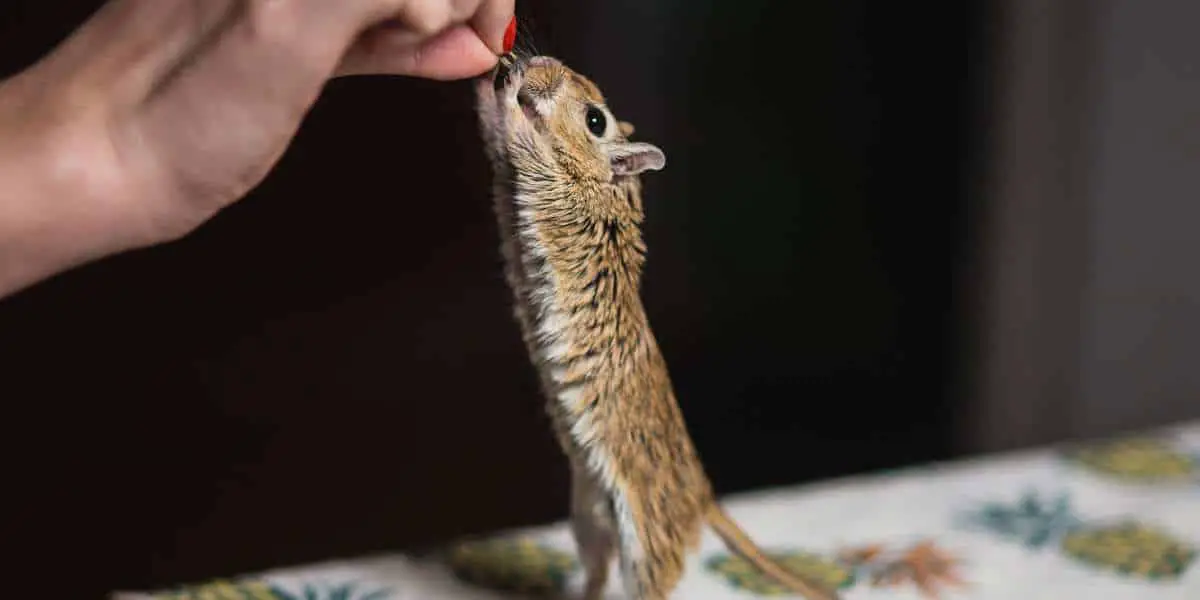Gerbils are intelligent, fun pets that you can easily train to do various tricks, commands, and behaviors. They are highly social animals that love interacting with their owners and can be quite obedient when it comes to learning.
This guide will provide tips and techniques on how to train your gerbil and teach it a variety of tricks and commands. So, let’s get started!
Table of Contents
What is a Gerbil?
A gerbil is a small species of rodent that originates from the deserts and other dry environments of Asia and Africa, where they live in large burrows. They are closely related to mice, but they have longer tails and smaller ears than their relatives. As pets, gerbils have become increasingly popular due to their intelligence and affectionate nature. With patient training, you can teach your gerbil a variety of tricks and commands that will make it an even more enjoyable pet.
Gerbils are incredibly active, so your first step should be to give them plenty of space to play and move around. You should provide at least one cubic foot of space for each gerbil that you own in order for them to stay healthy and happy.
You can do this by using a wire cage or aquarium with bedding on the bottom such as shavings or hay flakes. Be sure to include lots of toys like tunnels, runabouts, hide pens, wheels, ladders, and cuddle cups for your gerbil’s entertainment and exercise needs. Additionally, make sure you include food dishes, water bottles or drip systems, and chewing toys like blocks of wood or natural spools for your pet’s comfort as well as its mental stimulation.

Benefits of Training Your Gerbil
Gerbils are loyal, intelligent companions. Training them is one of the best ways to build and maintain a strong bond with your pet. In addition to strengthing a relationship, training your gerbil can offer several practical benefits such as improved socialization, better handling, and ease of vet visits.
Training provides the mental stimulation that ensures your gerbil stays happy and healthy both mentally and physically. Teaching them tricks is also an effective way to prevent potential problem behaviors that may arise out of boredom such as teeth grinding, obsessively running in circles, or testing cage bars for weaknesses. Plus, it’s very entertaining for both the gerbil’s humans and the house guests he comes in contact with!
Training will help you bond with your furry companion before taking him outdoors or introducing him to others because it helps your gerbil learn proper social behavior so that he is comfortable around humans as well as other animals.
As a result, trips to the vet or pet groomer can be stress-free experiences for both you and your pet. With training techniques like target practice on toys or hands (tapping on the hand with his nose) combined with rewards like treats and affection, you can communicate expectations like “come here” or “no bite” which will make him much more manageable when handled by humans outside their home space.
There are many benefits to training your gerbil including strengthening relationships while building trust, providing mental enrichment through activities that improve well-being, helping develop social behavior while laying the groundwork for smooth vet visits/ groomer appointments while preventing problem behaviors due to boredom in captivity; all resulting in an obedient companion who loves spending time together!
Getting Started with training your gerbil
Training your gerbil is a great way to bond with your pet and keep them healthy and entertained. It also helps to keep their minds sharp and active as they learn new commands and tricks.
If you’re ready to start training your furry friend, you’ll need to be prepared with the right equipment, snacks and instruction. Let’s take a look at the basics of gerbil training so you can get started.
Creating a Positive Environment
Creating a positive and nurturing environment for your gerbil is important when it comes to teaching them tricks and commands. This includes no yelling, punishing or frightening your pet when they do something wrong. A positive environment also means giving your gerbil special treats as rewards for good behaviors. These could include extra playtime with you, cheese, cookies or any other treat that your pet enjoys.
Another way to create a positive training atmosphere is by utilizing positive reinforcement. Positive reinforcement is simply rewarding your pet with attention and treats when they complete the task correctly. This technique will teach your gerbil that they can expect a reward when they obey the command that you’ve given them.
An important element of a successful training session is patience and consistency. You should not attempt any difficult stunts until after you have taken the time to properly train them through repetition on a regular basis. If your gerbil becomes stuck or makes a mistake, be patient!
You can always try again once he understands the command better. With repeated practice, repetition and patience, you will be able to successfully teach your gerbil fun tricks and commands in no time!
Establishing a Routine
Training your gerbil to respond to commands requires time and patience. To get started, establish a positive learning environment with consistent reinforcement of successful behaviors and prompt correction for unsuitable actions. To ensure your gerbil develops a routine, create achievable goals, and always remember to make the training sessions fun for both you and your pet!
Establishing a daily routine is also key in getting your gerbil to follow commands. Start by setting aside time each day for teaching so that your gerbil associates regular training time with positive experiences. A basic reward system can be used to help prevent behavioral issues — such as biting or sitting away from you — during the early stages of training.
If these issues are addressed quickly, it will save you having to develop more elaborate strategies later on in their training.
When teaching commands or tricks, it is important that all family members stick with the same methods when handling the gerbil so that they respond equally well to everyone in the house. Develop a consistent communication style when working with your pet and make sure everyone follows it. Doing this will also enable other members of the household to contribute effectively in helping teach new commands or tricks.
Finally, remember that certain techniques should never be used when training your gerbil — such as force or punishment — as these can be damaging and result in unwanted behaviors from them over time. Stick with positive reinforcement using verbal rewards whenever possible and avoid any negative strategies at all costs!
Teaching Tricks for your gerbils
Teaching your gerbil fun tricks and commands can be a rewarding experience. From teaching them to come when you call to teaching them to run obstacle courses, there is a lot of fun to be had with gerbil training.
Not only does it provide a fun activity for you and your gerbil, but it also benefits them by providing mental stimulation and helping to build the bond between you and your pet.
In this article, we’ll look at what you need to know to start training your gerbil.
Clicker Training
Clicker Training is a popular and effective method of training your gerbil. This method of teaching involves using food rewards to teach commands, tricks and other behaviors. The method is based on Positive Reinforcement, which means that the positive behavior will be reinforced with a reward when it is displayed correctly.
To begin Clicker Training for gerbils, ensure that you have a clicker device and plenty of treats to reward your pet with when they get things right. Before teaching any new trick or command, begin by getting the gerbil accustomed to the sound of the clicker.
Do this by clicking the device repeatedly in their presence, then rewarding them for any response given with a treat. Once they are used to the sound and understand that a treat follows it, you can move on to teaching basic commands such as ‘sit’ or ‘come’.
With simple commands such as these, start by saying the command in an authoritative voice while placing them in their preferred position – usually, one paw outstretched (ideally using your index finger as this can provide more control).
When they stay in that position for just a few seconds (providing they have not struggled against you), use the clicker to give confirmation before giving them a treat. This should be repeated frequently until they no longer require placement; just verbal command should suffice.
When moving onto trickier commands such as jumping through hoops or rolling around on command (for entertainment purposes), start by letting them explore and naturally figure out how to get it right before using confirmation with treats or clicks from the clicker device followed by treats.
Be sure not to rush your gerbil; take it slowly and only reward them when successful behaviors are accomplished!
Teaching Your Gerbil to Come When Called
Teaching your gerbil to come when called is a fun and fascinating way to build a bond with your pet. With some patience, positive reinforcement and a few simple commands, you can enhance the quality of playtime for both you and your gerbil.
The first step in teaching your gerbil to come when called is to become familiar with the process of conditioning. Conditioning is based on the idea that animals learn through positive reinforcement, or by rewarding desired behaviors with treats or playtime with their owners.
Start by providing verbal commands to your gerbil, such as “Come” or “Follow Me.” As soon as they acknowledge the command, reward them with a treat or some play time and praise them for their good behavior.
Food rewards are often considered the most effective incentive but verbal rewards, such as affectionate words and petting can also be used as incentives for training your gerbil. The key is to give them plenty of encouragement while they attempt each trick in order to reinforce desirable behaviors while avoiding any potential punitive measures that might hinder their learning process.
As you continue this process of repetition and reward it won’t be long before your gerbil begins coming when called without any prompting from you. Before long you will have created a strong bond between yourself and your pet through this additional form of interactive training that will provide hours of fun during playtimes together!
Teaching Your Gerbil to Sit
Teaching your pet gerbil to respond to your commands is a great way to develop a bond with the furry little critter! To get your gerbil to recognize a “sit” command, start by sitting on the ground next to and facing your gerbil’s cage.
Place a treat such as a sunflower seed or a commercial gerbil treat on the floor behind you and call out “sit” each time you put the treat down. As your gerbil walks closer and closer, it will recognize that when it hears the word “sit,” there is something tasty for him at the end of it.
Once he’s walking in front of you without hesitating, start holding the treat in front of his nose but slightly above his head so that he has no choice but to sit in order to reach it. Each time he eats from your hand like this with his rear end slightly elevated, give him positive reinforcement by providing verbal praise.
Eventually, he will learn what “sit” means and realize that if he sits when told, he gets rewarded. Once trained properly in this manner most place-trained gerbils will remain place-trained unless actively trained otherwise.
Teaching Commands
Training your gerbil to respond to commands is a fun, rewarding way to bond with your pet. Whether you want to teach your gerbil to come when called, or to stay put when asked, you can form a stronger relationship with your pet and encourage positive behaviors.
Let’s explore the basics of how to train your gerbil to respond to commands.
Teaching Your Gerbil to Follow Directions
By using simple commands and rewards, you can teach your gerbil to understand instructions and to perform some fantastic tricks. To begin, choose a few basic commands and always use the same phrase each time you want your gerbil to carry out an action. The most common commands are ‘Come’, ‘Sit’ and ‘Jump’. However, you can be creative with your phrasing; just make sure it is clear and consistent every time.
When teaching your gerbil a new command like ‘come’, start by interacting with it close up in its habitat and give the command each time as you move away from it. Reward it with treats for following the command, or allow it out of its habitat for playtime if that is something your gerbil enjoys. With repetition over several days or weeks (depending on how quickly your pet learns), it will eventually associate the command with the desired action or behavior.
In addition to teaching commands for obedience purposes, you can also teach behaviors such as running through a “tunnel” made from paper towel tubes or jumping from one platform onto another platform. You’ll want to start off by introducing individual components of whatever behavior/trick you are trying to teach (e.g., walking into the tunnel), then slowly build complexity until the full behavior is completed before rewarding it every time.
As exciting as this process may be at first glance, learning takes time; remember that patience is key when training any animal!
Teaching Your Gerbil to Stay
Teaching your pet gerbil to stay is an important part of its training. Training them to stay in one place will prevent them from running off and the command can be incredibly useful when returning them to their cage or when you need to transport them safely. To teach your gerbil the ‘stay’ command, you will have to start with a few basic steps.
First, equip yourself with treats that your gerbil likes, such as raisins, small pieces of banana or sunflower seeds. Make sure that your gerbil is comfortable in his surroundings before starting the training and have it sit on a flat surface like the floor or on a level tabletop. You’ll also want an area that is free of distractions for example away from active children or other pets. When you are both settled it’s time for the first step:
Step 1: Begin by holding out a treat at arm’s length while saying “stay” in an authoritative voice. Repeat this several times until your gerbil starts to understand what the word ‘stay’ means in relation to staying put when given a treat.
Step 2: Once they understand this connection start placing the treat further away and repeating the same process. Your goal with this step should be getting your pet comfortable with remaining still while you slowly move away from them with food in hand.
Step 3: Finally make sure they stay while you slowly increase your walking distance away from them until they are no longer receiving visual cues from you that may tempt them into leaving their post such as knowing when a treat will come next or if you are overcome by distraction and stop giving instructions altogether suddenly ending their training session prematurely because now all attention has been removed from it).
You can accomplish this by beginning at short distances like standing five feet apart then gradually increasing up towards twenty or thirty feet apart). If unsuccessful repeat the entire process until success has been achieved!
Conclusion
Training your gerbil is an activity that takes time and patience, but is incredibly rewarding for both you and your pet. From teaching your gerbil tricks such as how to run around an obstacle course or how to play fetch to more complex commands like Sit and Come, you can enjoy watching your pet’s progress and both of you learning something new.
Now that you know the basics of gerbil training, you can start teaching your pet some fun tricks and commands!
Tips for Successful Training
In order to ensure that you and your gerbil have a fun, successful training experience, here are some tips to keep in mind when you begin the process:
-Spend plenty of time getting to know your gerbil before attempting to train it. Training can take months and requires consistency and patience.
-Make sure that your gerbil is comfortable in its environment by providing plenty of food and water, hiding places, chew toys, tunnels, exercise wheels and anything else they need to feel safe.
-Reward positive behavior with treats, verbal praise or gentle strokes from a finger.
-Avoid punishment or scolding your gerbil as this will only make it scared of you and less likely to learn commands.
-Train for short sessions (no more than 20 minutes) several times each day in order for your gerbil to retain what it has been taught.
-Use simple commands with one action associated with each command, such as “climb” for climbing up a ladder or “go” for running inside a tunnel.
-Be consistent! Stick with the same command phrases and never give up too easily if you don’t see success right away — patience is key when training any pet!
Troubleshooting Common Training Challenges
Training a gerbil can be both incredibly rewarding and incredibly challenging. Although gerblas are typically intelligent animals that are capable of learning, there may be times when training does not seem to progress. In situations like this, it is important to identify the source of the difficulty in order to overcome it. Before assuming any problem is insoluble, consider the following possible causes:
Lack of Motivation – It can be difficult to make sure your gerbil remains motivated throughout its training program. Some gerbils may become quickly bored or lack sufficient interest in the rewards being offered. If this happens, try modifying your rewards system or providing more amusing activities that are still related to training.
Stress – Training can cause stress in some gerbils; this may lead them to become distracted or uninterested in participating in commands or activities. If you suspect that your gerbil is getting too stressed out by its training regimen, take a break and redirect its focus elsewhere with more basic activities before continuing where you left off.
Incorrect Rewards – Not all rewards will have equal significance for each individual gerbil; some animals may find one reward more attractive than another despite both being considered “treats” by their owners. When dealing with a particularly stubborn animal, experiment with different types of treats until you find one that really catches their attention and encourages them to keep working towards the command at hand!




